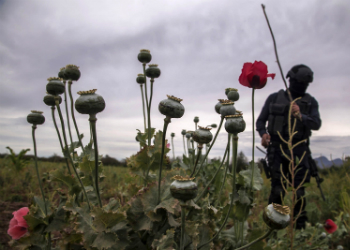
24 Jun Small Farmers Hurting in Mexico’s Poppy Growing Heartland
Tension is brewing among small farmers in a notorious poppy-growing region in Mexico over delivery delays of a government subsidized fertilizer, in just the latest issue facing farmers amid a growing shift away from heroin and towards synthetic drugs.
For 24 years, municipal and state authorities in southwest Guerrero state along Mexico’s Pacific coast have provided subsidized fertilizer to help local farmers grow corn. But these government subsidies have also been helping another group of farmers: poppy growers.
However, just 58 of the 132 fertilizer distribution centers in Guerrero — long Mexico’s heartland for growing poppy, the raw ingredient needed to make heroin — are in operation at the moment, according to Jorge Gage Francois, the state program’s director, Proceso reported.
SEE ALSO: Mexico News and Profiles
The problem, according to Gage Francois, is that some 400,000 farmers have registered to be a part of the program, 30,000 more than last year, which has caused delays in verifying each farmer’s operations. Roadblocks and the detention of public officials have also slowed the process of delivering fertilizer to registered farmers, according to Gage Francois.
Authorities have had suspicions for some time that the government subsidized fertilizer wasn’t only being used for growing corn. In August 2017, for example, federal security forces discovered one and a half tons of fertilizer on a poppy growing camp in Guerrero where nine growing fields had been destroyed.
InSight Crime Analysis
Delays in receiving government subsidized fertilizer are just the latest headache for farmers in Mexico’s poppy heartland, who have been hit extremely hard by a drop in heroin prices due to a rise in production and demand for synthetic drugs like methamphetamine and the deadly opioid fentanyl.
In 2017, “the value of the opium crop … outstripped the entire value of agricultural output in 26 of Mexico’s 32 states,” according to a 2019 study by the Network of Researchers in International Affairs (Noria).
Indeed, Mexico’s opium crop was valued at some 19 billion pesos (around $1 billion), significantly more than the value of beans ($846 million), wheat ($687 million) and cotton ($636 million) at that time, according to the study.
In 2018, however, the study estimated that poppy growers made between just five billion and seven billion pesos (between $261 million and $364 million), a more than 60 percent drop from 2017 that underscores the “radical decrease” in the value of the crop over that one-year span as criminal groups have adapted to meet drug market shifts.
SEE ALSO: Mexico’s Role in the Deadly Rise of Fentanyl
To be sure, several farmers just north of Guerrero in Sinaloa state — another historic hub for drug production in Mexico — recently told Ozy that the price for a kilogram of opium paste had fallen from $1,840 to just $500, backing up what Noria’s researchers found.
As the market demands have shifted, so have Mexico’s criminal groups. Just last year, for example, security forces in Sinaloa seized 50 metric tons of methamphetamine in what was believed to be the largest such bust in the country’s history. And as InSight Crime detailed in a 2019 investigation into Mexico’s role in the fentanyl trade, the Sinaloa Cartel and Jalisco Cartel New Generation (Cartel de Jalisco Nueva Generación – CJNG) — the country’s two most formidable crime groups — are “the most important Mexican purveyors of the drug and its precursors.”
[ad_2]
Source link




No Comments